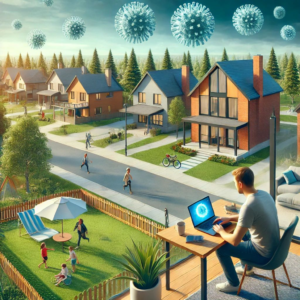
Why Suburban Properties Are Booming Post-Pandemic
The COVID-19 pandemic has had a transformative impact on many aspects of our lives, not least of which is the real estate market. One of the most noticeable trends has been the increasing demand for suburban properties. As urban centers grapple with overcrowding, rising costs, and lifestyle changes, the appeal of suburban living has skyrocketed. Here, we explore the reasons behind the suburban property boom and what it means for buyers, investors, and real estate developers.
—
1. Shift in Work Dynamics
Remote Work Revolution
The pandemic normalized remote work, with companies adopting hybrid or fully remote models. Employees no longer need to live close to their workplaces, allowing them to prioritize affordability, space, and quality of life. Suburban areas, with their larger homes and peaceful environments, have become the ideal choice.
Lower Cost of Living
Living in suburbs often translates to lower living costs compared to urban centers. From housing prices to daily expenses like groceries and transportation, suburbs offer a more budget-friendly lifestyle without sacrificing comfort.
—
2. Desire for More Space
Spacious Homes
Lockdowns highlighted the importance of having adequate living space. Suburban homes typically offer larger layouts, yards, and multi-functional areas that can accommodate home offices, gyms, or play areas for children.
Outdoor Living
With limited access to parks and open spaces during the pandemic, the value of having a private yard or garden became evident. Suburban properties cater to this need, making them more attractive to families and individuals alike.
—
3. Improved Infrastructure in Suburbs
Enhanced Connectivity
Suburban areas have seen significant improvements in infrastructure, including better roads, public transportation, and internet connectivity. These advancements make suburban living more convenient and appealing.
Access to Amenities
Modern suburbs offer amenities like shopping centers, healthcare facilities, schools, and recreational options. This ensures residents don’t feel disconnected from essential services.
—
4. Urban Challenges Post-Pandemic
High Cost of City Living
Urban housing markets have remained expensive, pushing many buyers and renters to explore suburban alternatives that offer better value for money.
Overcrowding Concerns
Health concerns related to dense urban living have prompted people to seek less crowded environments. Suburbs provide the space and tranquility that urban areas lack.
—
5. Rise of Smart Suburbs
Technology Integration
The integration of smart technology in suburban developments has made them more attractive. Features like smart home systems, energy-efficient designs, and high-speed internet cater to modern lifestyles.
Mixed-Use Developments
Developers are creating mixed-use communities in suburbs, combining residential, commercial, and recreational spaces. These self-sustained neighborhoods offer the best of both worlds: urban convenience and suburban peace.
—
6. Affordability and Investment Opportunities
Competitive Prices
Despite rising demand, suburban properties are often more affordable than their urban counterparts. This affordability attracts first-time buyers and investors looking for high-value returns.
Growing Rental Demand
As more people move to the suburbs, the demand for rental properties has also increased. This creates lucrative opportunities for investors in the rental market.
—
7. Family-Friendly Living
Better Education and Safety
Suburban areas are known for their high-quality schools, lower crime rates, and family-friendly communities. These factors make them a top choice for families seeking stability and a safe environment.
Community-Oriented Lifestyle
The sense of community in suburban neighborhoods is another draw. Residents enjoy closer social connections and opportunities for engagement compared to the often impersonal nature of city living.
—
8. Eco-Friendly Living
Green Spaces
Suburbs often offer more green spaces, parks, and nature trails, which promote a healthier lifestyle and reduce stress levels.
Sustainable Development
Many suburban developments are incorporating sustainable building practices and eco-friendly features, appealing to environmentally conscious buyers.
—
9. Suburban Areas Leading the Boom
Regional Highlights
United States: Cities like Austin, Phoenix, and Charlotte have seen significant suburban growth.
United Kingdom: Suburbs near London, such as Kent and Surrey, have experienced increased demand.
India: Areas like Noida and Pune are emerging as top suburban hotspots.
Australia: Suburbs around Sydney and Melbourne are thriving due to affordability and space.
—
Conclusion
The suburban property boom post-pandemic is not just a fleeting trend but a reflection of evolving lifestyles, priorities, and economic realities. As remote work becomes a permanent fixture, health-conscious living gains importance, and urban challenges persist, the suburbs offer a compelling alternative for homebuyers and investors.
If you’re considering buying or investing in real estate, now is the time to explore suburban properties. The combination of affordability, space, and quality of life makes them an excellent choice for the future.
For expert advice on suburban real estate opportunities, visit EasyPropertyDeal.com today!
FAQs: Why Suburban Properties Are Booming Post-Pandemic
1. Why are suburban properties in high demand post-pandemic?
Suburban properties are in high demand due to the rise of remote work, which allows people to live farther from city centers. Additionally, suburban areas offer larger homes, outdoor spaces, lower living costs, and a family-friendly lifestyle, which became more desirable after the pandemic.
2. How has remote work influenced the suburban property boom?
Remote work has removed the need for daily commutes, enabling people to prioritize space, affordability, and quality of life. Suburbs, with their spacious homes and peaceful environments, are now seen as ideal places to live and work.
3. Are suburban properties more affordable than urban properties?
Yes, suburban properties are typically more affordable than urban properties. Buyers can often find larger homes with better amenities at a lower cost in the suburbs compared to city centers.
4. What are the benefits of living in the suburbs?
Living in the suburbs offers several benefits, including:
Spacious homes and outdoor areas
Access to parks and green spaces
Lower crime rates
Better schools and family-oriented communities
More affordable cost of living
A quieter, less stressful environment
5. Are suburban areas well-connected to cities?
Modern suburban areas often feature excellent connectivity through highways, public transportation, and improved infrastructure. Many suburbs are also close to essential amenities like schools, hospitals, and shopping centers.
6. What are some popular suburban areas experiencing a boom?
Popular suburban hotspots include:
In the U.S.: Austin, Phoenix, and Charlotte suburbs
In the UK: Kent and Surrey
In India: Noida and Pune
In Australia: Suburbs around Sydney and Melbourne
7. Is investing in suburban properties a good idea?
Yes, investing in suburban properties can be lucrative due to rising demand for rental properties and relatively lower purchase prices. Suburban real estate offers good potential for long-term appreciation, especially in growing areas.
8. How have family needs influenced the move to suburbs?
Families prefer suburbs because they offer better schools, safer environments, and spacious homes with yards. The sense of community and proximity to parks and recreational facilities also make suburbs more appealing for families.
9. Are there any downsides to living in the suburbs?
Some potential downsides of suburban living include longer commutes (if working on-site), fewer entertainment options compared to cities, and a quieter lifestyle that may not suit everyone. However, these factors are often outweighed by the benefits.
10. What are mixed-use suburban developments, and why are they popular?
Mixed-use developments combine residential, commercial, and recreational spaces within the same area. These developments are popular because they offer urban conveniences like shops, restaurants, and offices while retaining the suburban appeal of space and tranquility.
11. How does the suburban boom affect urban property markets?
The suburban boom has led to decreased demand for urban properties, causing slower price growth in city centers. However, some urban markets are adapting by offering incentives or investing in revitalization projects to retain residents.
12. Will the suburban property boom continue in the future?
The suburban property boom is likely to continue as remote work becomes more permanent and people prioritize space, affordability, and a better quality of life. However, market conditions and regional factors will play a role in shaping future trends.
13. Are suburbs more eco-friendly than cities?
Suburbs often feature more green spaces and opportunities for sustainable living, such as energy-efficient homes and community gardens. However, longer commutes in car-dependent areas can offset some environmental benefits.
14. How can I find a good deal on a suburban property?
To find a good deal:
Research fast-growing suburbs with infrastructure development.
Compare property prices in different areas.
Work with a local real estate agent.
Use online platforms like EasyPropertyDeal.com to explore listings.
15. What types of buyers are driving the suburban property boom?
The suburban boom is driven by remote workers, young families, retirees, and investors seeking affordable properties with good long-term growth potential.
If you have more questions about suburban properties or need expert advice, feel free to reach out through our contact page.
